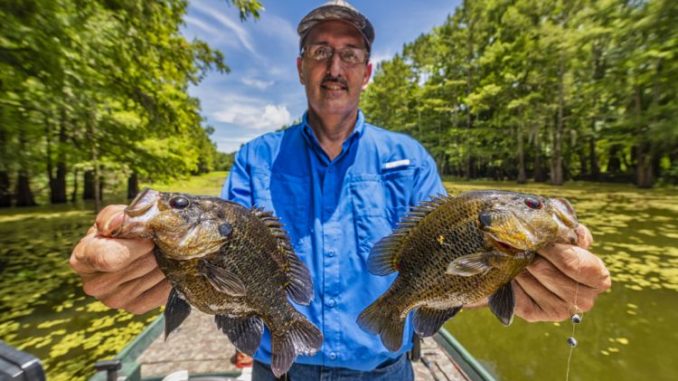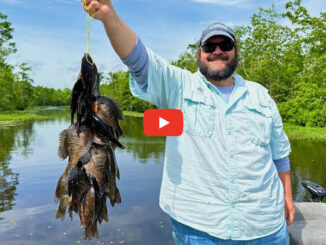
Falling water levels turn on the bream action
Darren Cooper and I sat in Doiron’s Store at 6:30 a.m., waiting for an early morning thunderstorm to pass over the lower Atchafalaya Basin. It had been several years since we had gotten together to catch bream in the huge swamp — and a slowly falling Atchafalaya River gave great promise to our day.
We weren’t disappointed — we returned to the landing six hours later with 60 bream cooling in the ice chest. And most of those were huge goggle-eye.
Not a single recreational angler was launching when we we pulled away from the dock — and this was on Saturday.
That was the first sign of a potentially fishless day. When we crossed Flat Lake, flag No. 2 began waving alarmingly.
Muddy water was everywhere. And I mean muddy: Flat Lake looked like it could be plowed.
As we continued to a little back water near Duck Lake, it didn’t get much better. Until we neared the honey hole that has delivered time and again for me.
No, I’m not going to tell you exactly where we caught fish. Because it really doesn’t matter: The real lesson is in what happened and how we caught them.
Besides, it’s a small area that will probably be covered with salvinia within the week, rendering it unfishable.
There was salvinia everywhere. Man, it’s going to be bad this year. One side of the canal was almost choked with the invasive vegetation, while more and more of the floating stuff moved in during the day.
But it didn’t take long to confirm fish were still there and ready to eat the 300 crickets chirping in the two boxes on my deck.
We quickly put a couple of fish in the boat — and they were monster goggle-eye, the very species Darren wanted to catch.
I used my tried-and-true slide-cork rig on a light-action spinning rod. The setup is perfect to reach under tree branches and make long casts.
My cork was the small, foam, red-and-white variant. I tied a small jighead on the terminal end of the line.
Fishing depth is set with a bobber stopper. I have fought those pre-tied twine stoppers until I finally gave up, since they constantly come untied and you have to re-rig everything when that happens.
I’ve found the rubber Eagle Claw stoppers designed for use with 8- to 14-pound test line work perfect, and they last forever. Just pull the stopper to the desired depth, and you can reel up and cast the rig easily.
Get step-by-step directions to build your own slip-cork rig here.
Darren, on the other hand, used a spincaster with a weighted cork that sounded like a brick hitting the water. The cork was as long as my finger, which made me wonder aloud if the fish could even pull the thing under.
“It doesn’t take anything to pull the cork down,” he said. “That’s not a problem.”
Indeed, he could detect the smallest nibble with the cork. An upside of the huge plastic bobber is that it sits high above the water, so it was obvious when it bobbled down even a little.
Both rigs worked equally well.
To be honest, however, we probably would have been better served with jig poles: More often than not we were fishing holes in the salvinia mats, which made casting difficult.
The trick to catching the goggle-eye that teemed in this canal was to fish the shady side of the cypress trees. Stumps produced nothing. Laydowns gave up a few. Live trees held most of the fish.
Unfortunately, the fish don’t seem to be bedding.
“They’re scattered,” Darren observed. “We’re just picking them up here and there.”
Small fish were up shallow, with the monster goggle-eye coming from around the outside trees. We were fishing about 14 inches deep.
But even there, we had to weed through smaller fish.
We ended the day with 62 bream in the box, but we caught many more than that. And we were picky: Goggle-eye and bluegill we normally would have kept were released because we didn’t need them to ensure food on the table for two families.
On our way out, we made a run down Little Bayou Sorrel to check water conditions elsewhere, and we found pretty water bleeding out of the swamps, so there is clean water to be found. Find that, and the odds are good you’ll find fish.
A couple of words of caution, however.
First, summertime means wasps are active. There were two red wasp nests as big as my head and a fist-sized nest full of yellowjackets that bristled every time we got within 20 yards on the canal we fished.
Second, it’s hot. I know that’s not a surprise to anyone, but it bears keeping in mind. We fished until 12:30 p.m., and by that time we were drained. Darren actually got a bit nauseous, and he spends a lot of time outside.
The fact is that we were so busy catching fish that we forgot to drink water until late in the morning.
So make sure you have plenty of water and some Gatorade to stay hydrated. And drink it early and often.
The good news is that the fish in the lower Basin aren’t being pounded on yet — and the action will only get better as the Atchafalaya River continues to fall.
